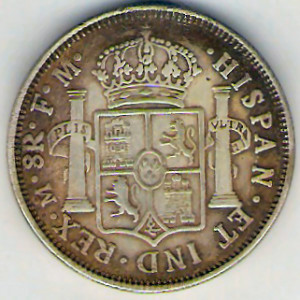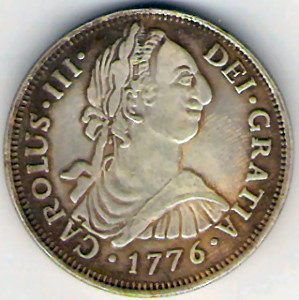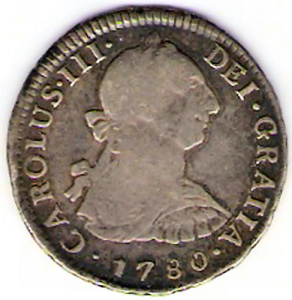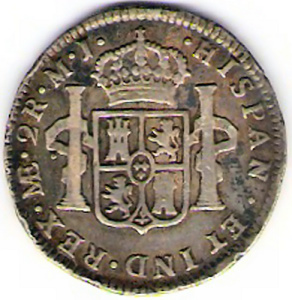

![]() There exists, in the modern psyche, a romantic image of pirates and pieces~of~eight. The pirates, we know from historical accounts and trial transcripts, were very real. Perhaps some of their exploits were exaggerated, but there were indeed a number of them, especially English and French ones. And those English and French pirates tended to prey upon Spanish galleons. Those Spanish galleons were transporting troops to the colonies in the New World, and those troops were plundering native stockpiles of gold and silver. The gold and silver was then being shipped back to Spain in the ships that the troops had come over in. Laden with treasures and manned by reduced crews (the space for the rest being taken up by the silver and gold cargo), the Spanish galleons were easy prey for the English and French pirates. It's all very romantic with celluloid blood spurting from swashbuckling sword fights and all.
There exists, in the modern psyche, a romantic image of pirates and pieces~of~eight. The pirates, we know from historical accounts and trial transcripts, were very real. Perhaps some of their exploits were exaggerated, but there were indeed a number of them, especially English and French ones. And those English and French pirates tended to prey upon Spanish galleons. Those Spanish galleons were transporting troops to the colonies in the New World, and those troops were plundering native stockpiles of gold and silver. The gold and silver was then being shipped back to Spain in the ships that the troops had come over in. Laden with treasures and manned by reduced crews (the space for the rest being taken up by the silver and gold cargo), the Spanish galleons were easy prey for the English and French pirates. It's all very romantic with celluloid blood spurting from swashbuckling sword fights and all.
![]() And then there's the /pieces~of~eight. Before being banned from public school libraries due to PG-13 violence and language, Robert Louis Stevenson's Treasure Island was required reading for schoolboys and girls. And in the depths of that volume we first learned about pieces~of~eight.
And then there's the /pieces~of~eight. Before being banned from public school libraries due to PG-13 violence and language, Robert Louis Stevenson's Treasure Island was required reading for schoolboys and girls. And in the depths of that volume we first learned about pieces~of~eight.

![]() During the Colonial Period, the Spanish equivalent of a U.S. dollar or English pound sterling was the eight reales Peso~De~Ocho, variously known in trade as Pillar Dollars (due to their distinctive design which included the Pillars of Hercules depicted on the reverse). They became known in English as Pieces~Of~Eight (which is the translation of 'peso de ocho'). There were also Four Reale coins, Two Reale coins, and One Reale coins. Four reales were the equivalent of 50% of the total dollar; they were known as four 'bits'. Two reales were the equivalent of 25% of the total dollar; they were known as two 'bits'. And one reale, or one 'bit' was the equivalent of 12.5% of the total dollar.
During the Colonial Period, the Spanish equivalent of a U.S. dollar or English pound sterling was the eight reales Peso~De~Ocho, variously known in trade as Pillar Dollars (due to their distinctive design which included the Pillars of Hercules depicted on the reverse). They became known in English as Pieces~Of~Eight (which is the translation of 'peso de ocho'). There were also Four Reale coins, Two Reale coins, and One Reale coins. Four reales were the equivalent of 50% of the total dollar; they were known as four 'bits'. Two reales were the equivalent of 25% of the total dollar; they were known as two 'bits'. And one reale, or one 'bit' was the equivalent of 12.5% of the total dollar.

![]() In the romantic version of the pirate story, a pirate would cut one of his Eight Reale coins into 'pieces' if he needed less than the total dollar amount. (A bottle of rum might have cost one dollar and two bits.) And so we have the romantic image of pirates carrying whole coins, coins cut in two, and little pie-slice pieces - because he was all the time cutting his eight reale Peso coins into smaller segments.
In the romantic version of the pirate story, a pirate would cut one of his Eight Reale coins into 'pieces' if he needed less than the total dollar amount. (A bottle of rum might have cost one dollar and two bits.) And so we have the romantic image of pirates carrying whole coins, coins cut in two, and little pie-slice pieces - because he was all the time cutting his eight reale Peso coins into smaller segments.


![]() But we have a problem with that romantic image. Why don't we have hoards and hoards of little pie-slice segments of these coins? If the entire, whole coins could survive through the years, allowing us to find them in treasure troves and in people's attics, why don't we find the segments? The only segments that I have seen were groupings of eight segments recently cut from a whole coin in order to illustrate what the pirates were doing all the time to their own coins. Did the segments dissolve after they were cut from the whole coin? The fact of the matter is that, more than likely, the romantic image of the coin being cut into smaller segments came moreso from the name being misunderstood rather than being representative of a physical act of actually cutting the coins into segments.
But we have a problem with that romantic image. Why don't we have hoards and hoards of little pie-slice segments of these coins? If the entire, whole coins could survive through the years, allowing us to find them in treasure troves and in people's attics, why don't we find the segments? The only segments that I have seen were groupings of eight segments recently cut from a whole coin in order to illustrate what the pirates were doing all the time to their own coins. Did the segments dissolve after they were cut from the whole coin? The fact of the matter is that, more than likely, the romantic image of the coin being cut into smaller segments came moreso from the name being misunderstood rather than being representative of a physical act of actually cutting the coins into segments.
![]() The name Piece~Of~Eight did not signify that the coin was intended to be cut into so many segments. If that were the case, the design on either the reverse or the obverse would have included grooves making the cutting into such segments easier. The name Piece~Of~Eight implied that the coin was one 'piece' (Spanish: peso, meaning dollar) consisting of eight reales. If the Spanish Treasury had intended the eight reales coins to be cut into segments, there would have been no reason for them to mint the Four Reales, Two Reales, and One Reales coins.
The name Piece~Of~Eight did not signify that the coin was intended to be cut into so many segments. If that were the case, the design on either the reverse or the obverse would have included grooves making the cutting into such segments easier. The name Piece~Of~Eight implied that the coin was one 'piece' (Spanish: peso, meaning dollar) consisting of eight reales. If the Spanish Treasury had intended the eight reales coins to be cut into segments, there would have been no reason for them to mint the Four Reales, Two Reales, and One Reales coins.
![]() Take notice, in the topmost image, along the left edge, is the numeral/letter: 8R signifying that the coin is a peso of eight reales. Also notice that the bottom coin, in the photo on the left, also appearing along the left edge, is the numeral/letter: 2R signifying that the coin is a peso of two reales. (I wonder why they never became known as pieces~of~two?)
Take notice, in the topmost image, along the left edge, is the numeral/letter: 8R signifying that the coin is a peso of eight reales. Also notice that the bottom coin, in the photo on the left, also appearing along the left edge, is the numeral/letter: 2R signifying that the coin is a peso of two reales. (I wonder why they never became known as pieces~of~two?)
